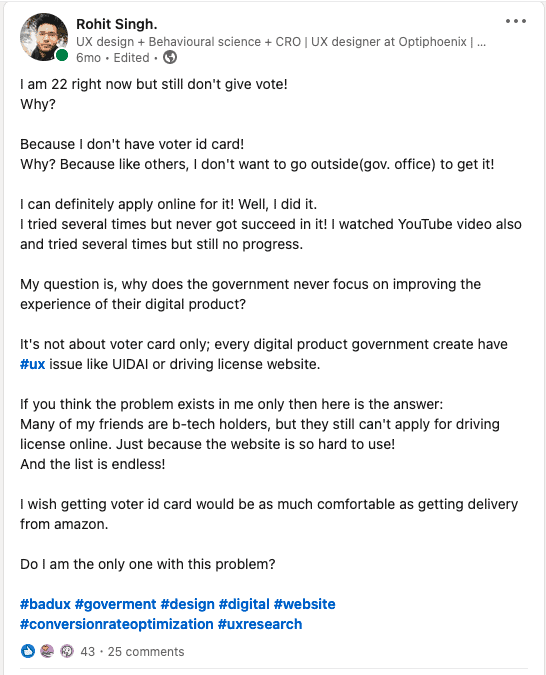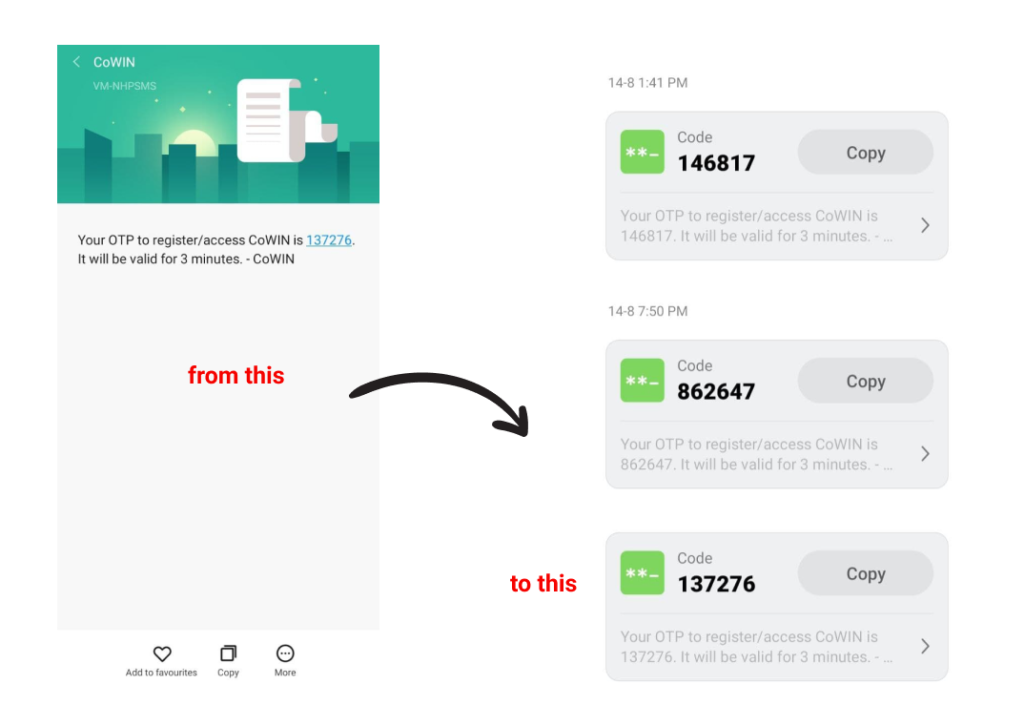A few months back, I made a post on LinkedIn where I had criticized the government for not making their digital products user-friendly.

At that time, My problem was that I could not get my voter id card due to the hard-to-use interface.
After eight months of that post, I realized that it was neither the government’s fault nor their hard-to-use interface because I had previously used a much harder user interface to fill my college admission form.
So why I posted on Linkedin blaming the government even though I had used a much harder interface before?
I never asked for anyone help in getting my id card which I could do! Also, I can apply offline, but I never did.
Yes, it’s a pure example of a lack of motivation, but we can’t always blame motivation for our actions.
Tell me one thing do you need motivation to watch Netflix or use Facebook? No! because it’s so easy to use, you have to make 3 clicks, and you are done. No need for motivation, right?
.
In his book, “Choice hacking“, Jennifer L. Clinehens has talked about it.
Even in his bestselling book “Atomic habit”, Jamesclear also talked about it; here are a few lines of that book:
“When you have to build a habit, make it easy and when you want to quit a bad habit make it hard“.
from atomic habit
So many people had talked about it in different ways because it’s so obvious but, still, many people neglect it! The principle is knowing as
Make it easy
Making things easy are directly related to our survival because Easy things equal more energy savings! And You already know why saving energy is essential for our survival.
Here is a little story before reading further:
Ron was in his late twenties. He had decent grades at school and a job he enjoyed. He was already an assistant manager and growing fast. His employer, a large retailer, offered good benefits, including an excellent pension.
He remembered the details from when he first joined and from a seminar they did for staff the previous year. For every pound he put in, his employer would put in the same again, and the government added more on top. It was a no-brainer, and he knew it. The only problem was, Ron hadn’t signed up.
Like many people, Ron knew that he should start saving for his pension, which he wanted to do. He’d seen his grandparents struggle with money, and though one or two of his friends joked that you should ‘spend it while you’re young, he knew that a few pounds put away now would be worth a lot more in the future.
But it also involved paperwork, a bit of hassle, and it didn’t feel like something that had to be done today. Retirement was years away. It was something Ron could do tomorrow, a consideration in the back of his mind. ‘Yes, he thought, ‘I’ll do it tomorrow, or maybe next week.’ This week was, after all, a bit busy.
In 2012, something happened. His employer wrote to him to say that, due to a slight change in the law, they would now automatically enrol him in the company-sponsored pension scheme unless he indicated that he would rather not.
If he didn’t want to enrol in the scheme, for now, it was simple. He just had to ask to leave the scheme within a month, and he would get another prompt in a couple of years.
The ‘default’ had been flipped: from one in which Ron would have to choose to join a pension scheme actively (‘opt in’) to one in which he would be automatically enrolled on to the company pension plan unless he said otherwise (‘opt out’).
Ron read the letter and went to a short talk on the new arrangements. It was a bit of a relief. He didn’t have to do anything. His pension was sorted.
In short, more than 90 per cent of eligible workers chose not to opt-out. The proportion of the employees of large firms saving for pensions rose from 60 per cent to over 80 per cent.
I also have the similar problem as Ron have!
Even though it will take me 3 hours to reach to voter id centre to get a card, I am still not doing it!
Why? Because it’s not easy, I have to prepare myself, use a vehicle to reach the centre, wait in line, fill in the form, and get back home.
As you can see, there is a significant amount of friction here, as we all had read in high school about friction.
It is an external force that stops things to move. It’s a similar thing, except it’s in our brain(psychological) and stops us from doing the action.
I hope you understood the power of “making things easy” and removing the friction as much as possible!
Friction is not just a word it could change a human behaviour completely.
Consider, this story!
In the early 1960s, the suicide rate in England and Wales began to fall. It was not unusual for the rate to fluctuate from year to year, so it went largely unnoticed at first. But from 1963, the suicide rate for both men and women fell for seven consecutive years. In less than a decade, the suicide rate fell by around 30 per cent.
Was this some excellent result of free love? But if so, why was this trend not being seen in other countries over the same period? What was going on?
The answer came when researchers broke the trends down by type of suicide. It turned out that the fall in suicide concerned one particular method: carbon monoxide poisoning. Until the early 1960s in Britain, one of the most common ways of committing suicide was to ‘stick your head in the oven’ – you turned on the gas, put your head in the oven, and the carbon monoxide in the gas would quietly kill you.
But in the early sixties, the gas source in people’s ovens began to change following the discovery of North Sea gas. Unlike the previous gas had derived from coal, the new North Sea ‘natural gas’ had much lower levels of carbon monoxide.
Putting your head in the oven with the North Sea gas(new gas) might give you a headache – and could put you at risk of blowing up your kitchen – but it was unlikely to kill you.
Even though people have other ways of killing themselves, now they have to find another way to kill themselves.
Have you seen the power of friction? It just saved the life of 30% more people.
Even a small amount of friction is enough!
In 1980, the Federal Republic of Germany (West Germany) introduced spot fines on motorcyclists for not wearing helmets. The primary motivation was to reduce head injuries, but it had an unexpected and dramatic impact in a different area: thefts. In the wake of the change, motorcycle thefts fell by 60 per cent and stayed down.
You might think that if a person intended to steal a bike, this change in the law would not make that much difference: they just had to remember to bring a helmet with them, or to steal one, too.
Riders often carried their helmets with them rather than leaving them on the bike. In short, the requirement to wear a helmet introduced ‘friction’ to the act of stealing a motorbike, with dramatic consequences.
100,000 reductions in motorbike thefts. Texas saw a reduction of 44 per cent in motorcycle thefts from 1988 to 1990 following the requirement to wear helmets.
Britain and the Netherlands saw comparable reductions in thefts of a third or more when laws were changed to require helmets in the 1970s.
.
As of now, you have understood that humans have a deep-rooted tendency to take the line of least resistance, be it cutting corners across a park, deciding what to watch on TV, to what to eat.
Also, we learned that friction could also be used for better things. It depends on the goal!
Now, Let’s see how the digital world uses these two basic principles to make the digital product better!
Paypal uses friction to help users avoid sending the wrong amount of money when they are in a hurry! By showing the written digit from right to left, rather than left to right!

Similarly, I talk about making things easy. Our surrounding is already filled with lots of examples! For example: When you want to text someone, just open WhatsApp and send a text. Oh, want! To watch a movie, open netflix.com or how about amazon prime?
There is no need to do anything hard. Also, I don’t think there is any need to discuss this principle and its use case in the digital world.
But still, sharing some of my favourite examples below.

In India, if you want to get money in your bank account, you have to share your bank account details (specifically Account number and IFSC code). Normally, no ones remember their bank account number due to a long string of number.
For example, My bank current number is something like this 6000382749483. Now, tell me could you remember? No!
So Paytm.com – a digital payment app of India, opened its own bank. The most amazing thing about this bank is they don’t give you a random string of numbers.
Rather than that, they will assign you your phone number as your bank account number!
Isn’t it easy to remember your phone number as a bank account number rather than remembering random digits?
Conclusion
We learned that why making things easy and removing things is so important. These two basic principles are related to human survival and can a business to grow easily.
Also, we learned that friction could be an enemy and a life saviour. It depends on your goals and how you use these weapons. I hope you will use it in your next design project.
Thanks for reading!

